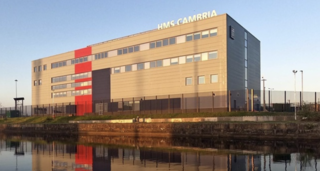In the Royal Navy and other navies of Europe and the Commonwealth of Nations, ships are identified by pennant number. Historically, naval ships flew a flag that identified a flotilla or type of vessel. For example, the Royal Navy used a red burgee for torpedo boats and a pennant with an H for torpedo boat destroyers. Adding a number to the type-identifying flag uniquely identified each ship.

The Belgian Navy, officially the Naval Component of the Belgian Armed Forces, is the naval service of Belgium.

Damerham is a rural village and civil parish in the New Forest district of Hampshire, England, near Fordingbridge. The area has notable Neolithic and Bronze Age barrows. It was the site of an Anglo-Saxon religious community, mentioned in the will of Alfred the Great. By the time of Domesday Book (1086), Damerham was a major settlement in the possession of Glastonbury Abbey. The village has a riverside mill and a Norman church.

The Ham class was a class of inshore minesweepers (IMS), known as the Type 1, of the British Royal Navy. The class was designed to operate in the shallow water of rivers and estuaries. All of the ships in the class are named for British place names that end with -"ham". The parent firm that was responsible for supervising construction was Samuel White of Cowes, Isle of Wight.
HMS Asheldham was one of 93 ships of the Ham class of inshore minesweepers.
HMS Elsenham was one of 93 ships of the Ham class of inshore minesweepers.
HMS Isham was a Ham-class minesweeper of the Royal Navy.
HMS Ledsham was one of 93 ships of the Ham class of inshore minesweepers.
HMS Rampisham was one of 93 ships of the Ham-class of inshore minesweepers.

HMS Shipham was one of 93 ships of the Ham-class of inshore minesweepers.

HMS Sidlesham was one of 93 ships of the Ham-class of inshore minesweepers. Their names were all chosen from villages ending in "-ham". This minesweeper was named after Sidlesham in West Sussex.
HMS Thornham was one of 93 ships of the Ham-class of inshore minesweepers.
HMS Yaxham was one of 93 ships of the Ham class of inshore minesweepers.
HMS Tongham was one of 93 ships in the Ham-class of inshore minesweepers. Their names were all chosen from villages ending in -ham; in this case, Tongham in Surrey. She was built in Scotland by James N Miller & Sons at St Monance, Fife, with a fully-wooden hull. Launched on 30 November 1955, she was delivered on 18 June 1967, and commissioned with pennant number M2735.

HMS Cardigan Bay was a Bay-class anti-aircraft frigate of the British Royal Navy, named after Cardigan Bay, off the coast of Ceredigion, Wales.
HMS St Brides Bay was a Bay-class anti-aircraft frigate of the British Royal Navy, named for St Brides Bay in Pembrokeshire. In commission from 1945 to 1961, she served in the Mediterranean and Eastern Fleets, seeing active service in the Korean War.

HMS Cambria is the lead Royal Naval Reserve unit in Wales. It is based in the docks of the Welsh capital, Cardiff.
HMSAS Bloemfontein was an Algerine-class minesweeper built for the Royal Navy in Canada during World War II. The ship was originally HMS Rosamund and spent several years clearing minefields in European waters after she was completed in 1945 before she was placed in reserve. Rosamund was purchased by South Africa in 1947 and renamed HMSAS Bloemfontein in 1948.






